ROBERT DOISNEAU
Graziella Colombo

What attracts, and drives thousands of visitors to see a photographic exhibition? Is it the photogra- pher’s fame? Is it their technique, nostalgia for a past to be rediscovered or the photographer’s use of greys or colour? Can it be the desire to know dif- ferent places, environments, people or situations? Or perhaps is it curiosity or the desire for some- thing beautiful and quick to see, not very demand- ing yet engaging? Perhaps it awakens a memory, evokes a place of a fleeting moment experienced, or perhaps as in the recent show in Milan of the work of Robert Doisneau, it creates an iconic image that viewers would like to believe emblematic of their culture and their time and place, and creates a his- tory of that place that people then associate with their memories or identify that image with that place, creating a fictional history based on a se- quence of images.
In Milan, an exhibition of 130 photographs by the father of French humanist photography, Robert Doisneau was shown at the Museo Diocesano ‘Car- lo Maria Martini’ in Milan from May 9, to October 15, this year. Doisneau (1912-1994) left a legacy of about 450,000 negatives. The exhibition recounts the artist’s journey through 130 black and white images created between the 1930s and 1960s in the collection of the Atelier Robert Doisneau in Mon- trouge, south of Paris. During these decades Dois- neau developed themes dear to him throughout his career: the war of liberation, work, love, children, free time, bistros, everyday life in the suburbs and on the street. He photographed Parisians, which he claimed as his subject, including Jacques Prevert, Picasso, Leger, Giacometti, Tinguely, Malraux and the ordinary Parisians. After the darkness of the war he wanted to represent joy, vitality, the desire to dance, joke,and rejoice in new found life show- ing a humanity and a life for us now distant in time to which the artist dedicated great attention. In his photos we find gestures, feelings, attitudes, emo- tions and desires of a world that no longer exists. From the 1930s to 1940s in Paris. His protagonists are the Parisians and a vanished city, overtaken by modernity, by changes, by today’s world. Doisneau left a testimony of an era seen through his eyes and his heart. Many children are portrayed, because children are easy to portray, so simple, available and playful and Doisneau plays with them, depict- ing their indeterminate future but joy in the mo- ment.
Between 1934 and 1939 Doisneau worked as an offi- cial photographer for Renault and this allowed him to develop a strong sensitivity towards workers and overall towards a modest social context. Poetry, tenderness and a great sense of humanity are never lacking in his exterior and interior shots, in bistros, in wedding processions, along the banks of the

Seine and always in the street which he considered a true school of life. Some photos show irony as in the case of Le fox terrier du Pont des Arts (1953). Do- isneau said “We were a small, nice group in a café on the rue de Seine. With us was a girl whom a friend painter wanted to portray on the Pont des Arts. I suggested he paint her naked, to see how people would react. Hence was born the image of the man with the fox terrier”.
He portrayed celebrities as well as relatives, friends, acquaintances who were often present and whom he asked to repeat the scenes: if some photos are spontaneous, many others are reconstructed (as in the famous Basier de l’Hotel de Ville, 1950). Here everything was posed, the lovers, the pas- sers-by, the place for a memorable shot. In reality the photo is not spontaneous because Doisneau was constructing a page for Life magazine and their request for a constructed and perfect pose. As soon as it was published, the photo became the symbol of a generation and the idea arose in the world, of a bohemian Paris, a Paris for lovers, a Par- is of freedom. However, what remains is imagina- tion, sensitivity and his personal and independent way of seeing and fixing reality. A great exhibition, truly exciting and engaging which justifies its suc- cess. He constructed more than an image, or a page in a magazine. He composed a symbol, an iconic image that bore a perhaps fictionalized image of a bohemian Paris, fully of joie de vivre and sponta- neous love, that became real to the viewers that saw and adopted it. A photograph that was seen as truth, because it was a real scene, although con- structed, became real for the generation that saw it and became history for those who view it now.

